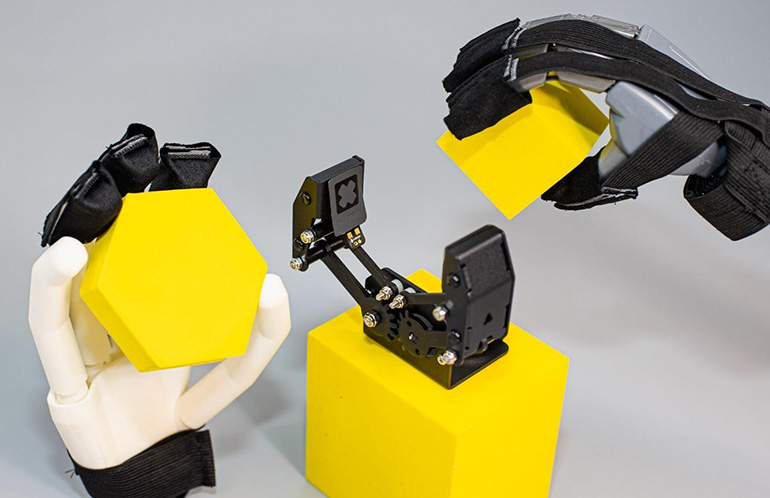
The Loomia Smart Skin Developer Kit can help roboticists test flexible tactile sensing. Source: Loomia
Most robots, including emerging humanoids, don’t have the ability to sense what they’re touching. Last week, Loomia launched its first tactile sensing developer kit. It’s the result of the company’s interviews with more than 100 engineers working on industrial automation, medical devices, and humanoid robots as part of the National Science Foundation’s I-Corps program.
“We didn’t set out to build a robotics product,” stated Maddy Maxey, founder of Loomia. “But again and again, we heard that pressure sensing was the missing piece in robotic hands and grippers—and that there just weren’t robust, flexible, plug-and-play solutions on the market.”
Founded in 2014 as “The Crated,” a design and technology studio, Loomia builds patented soft circuit systems that enable sensing, heating, and lighting in environments where traditional printed circuit boards (PCBs) cannot perform. The Brooklyn-based company has obtained 10 U.S. patents, and its Loomia Electronic Layer (LEL) has been deployed in automotive, industrial, and robotics applications.
Tactile sensors get flexible
Loomia first developed flexible tactile sensors in 2018, when it built a glove-based pressure matrix for industrial automation firm Festo. Since then, the company has shipped more than 1,000 sensors to enterprise clients, helping them prototype custom formats in nontraditional geometries and sensitivity ranges.
“Robots can see, but they still struggle to interact with the physical world,” Maxey said. “Without tactile input, they drop objects, fail grasps, or over-grip fragile items. Cameras can’t solve that. Sensors like these can.”
Loomia said the new kit is its “first off-the-shelf product for the robotics community and is intended to serve R&D labs, hardware startups, and researchers building the next generation of human-centric machines.”

Loomia has developed soft tactile sensors that can be woven into fabric. Source: Loomia
Interviews identify developer challenges
“When the NSF chose us for the I-Corps program for brining technology out of the lab to the market, it asked us to conduct two rounds of interviews,” recalled Sena Birsen, marketing and business development associate at Loomia. “The first was in automotive — not only OEMs, but also Tier 1 suppliers. Loomia’s technology is already used in that sector, in sensing plus heating applications in automotive interiors, for example. We also have prior customers in the medical industry.”
“For the second round, we didn’t have that many insights on the robotics side,” she told The Robot Report. “We were around five people and did our research to find people from humanoid and automation companies who worked with robotic hands, grippers, or AR and VR gloves. We asked if tactile sensing was important to them and what were their needs.”
Loomia identified several recurring challenges across robotics teams:
|
Challenge |
% of Teams Affected |
| Sensor drift and instability | 91 |
| Rigid sensor formats hard to integrate | 87 |
| Sensors failing during initial testing | 67 |
| Sensitivity needs below 2 Newtons | 78 |
| Preference for plug-and-play tools |
100 |
The company found that tactile sensing is a bottleneck for robotics developers, even as computer vision and artificial intelligence models advance. Goldman Sachs has estimated that 17% of humanoid robot development budgets go toward gripper technology — more than any other subsystem.
“We also heard that tactile sensors were expensive, not reliable, and gave inconsistent feedback that broke workflows,” said Birsen. “They also said they took a long time to set up and test. We tried to find a solution that could actually help these robotics people test and integrate them into their projects.”
Loomia Smart Skin Developer Kit is now available
Loomia said its new kit gives roboticists a platform to test, prototype, and integrate tactile sensors with minimal setup. It includes:
- A three-finger tactile sensing glove
- Capacitive sensors able to detect forces below 0.01N
- Mini and large pressure matrix arrays
- Peel-and-stick variants for on-robot application
- Static weight kit for calibration
- Arduino-compatible visualization software
- Two hours of direct engineering support

The Loomia Smart Skin Developer Kit includes a range of sensors. Source: Loomia
The sensors use the proprietary LEL, a soft-circuit system tested for stretching, twisting, abrasion, and environmental cycling. The kit will also ship with a detailed durability report.
“We had our on pressure sensors from before this kit — the mini and mega matrices are among the most popular sensors we offer,” Birsen said. “But these capacitive sensors have much higher sensitivity and are much more stable than other solutions available on the market. They can detect feather-like touches.”
“We’re iterating on what we had and are bringing a solution for robotic hands that is more sensitive, stable, and provides more consistent feedback,” she added. “We’re reaching out both to past customers and to the big humanoid companies.”
The Loomia Smart Skin Developer Kit is now available for pre-order for $4,900, and it will begin shipping on Nov. 30.
